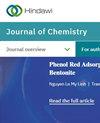Determination of Some Selected Heavy Metals in Effluents from Lubricants Manufacturing and Associated Contamination of Oysters (Crassostrea cucullata) and Soil near Discharge Points in Mombasa, Kenya
IF 2.6
4区 化学
Q2 CHEMISTRY, MULTIDISCIPLINARY
引用次数: 0
Abstract
Purpose: Available reports on heavy metal contamination along the Kenyan coastal zone focused on concentration levels in marine and coastal waters, sediments and biota, with indications of potential sources. However, information on contribution of specific sources to the heavy metal load into the marine and coastal environment is scanty or unavailable. Thus, this study addressed the need to assess specific potential sources and their contribution to heavy metal contamination. The generated data can be applied for monitoring discharge loads of heavy metals from lubricant manufacturing processes into the environment, its level of contamination to the environment and the potential risk to man through food chain. Materials and Methods: Concentrations of selected heavy metals Cd, Cr, Cu, Pb, and Hg in effluents filtrates, residues (SPM), Oysters (Crassostrea cucullata) and soil samples were determined using ICP-OES. The procedures of the analytical methods and instruments used were validated with analysis of a multi-element certified reference material (CRM IAEA-452) for the elements Cd, Cr, Cu, Pb and Hg in the effluent samples and standard reference material (SRM 1566b) from National institute standards and technology for the elements Cd, Cr, Cu, Pb and Hg in the marine bivalve tissues. Physico – chemical parameters Temperature, PH, Conductivity, Dissolved oxygen and Total organic carbon were also determined in the effluent samples. Sampling was done in the year 2021 and 2022. Effluent samples were collected from OLA energy Kenya limited, VIVO energy Kenya limited and TOTAL energy Kenya limited. Oyster samples and soil sediment samples were collected from Makupa creek. Data analysis was carried out using (SPSS) for Windows (Version 16) and one way analysis of variance (ANOVA) at 95% confidence level. The difference in mean concentrations of heavy metals within and between groups were considered significant at P˂0.05. The interrelationships of heavy metals contamination in the samples were determined using the Pearson correlation coefficient. It was considered significant at P value ˂0.05. Findings: This study showed presence of heavy metals that varied in concentrations in effluents samples, soils samples and Oyster samples. The mean concentrations of heavy metals in the effluents filtrates ranged as follows Pb = 0.0038±0.0004 mg/l – 0.0025 ± 0.003 mg/l, Cu = 0.0054±0.0038 mg/l – 0.0019±0.0002 mg/l, Cr = 0.0071±0.0021mg/l – 0.0045±0.0022 mg/l, Cd = 0.0041±0.0026 mg/l – 0.0013±0.0001 mg/l and Hg = 0.0063±0.0018 mg/l – 0.0026±0.0004 mg/l. The range of values for the mean concentrations of the heavy metals in the Oysters showed that Pb = 0.0227±0.0091mg/kg – 0.019 ± 0.006 mg/kg, Cu = 0.0618±0.0171mg/kg – 0.0601±0.0168 mg/kg, Cr = 0.0265 ± 0.0277 mg/kg – 0.0152 ± 0.0009 mg/kg, Cd = 0.0464±0.0282 mg/kg – 0.0273 ± 0.0117 mg/kg and Hg = 0.0264±0.0158 mg/kg – 0.025±0.0080 mg/kg. The range of values for the mean concentrations of the heavy metals in the soil samples showed that Pb = 0.0523 ± 0.0189 mg/kg – 0.0447±0.0181 mg/kg, Cu = 0.3010 ± 0.0282 mg/kg – 0.2437 ± 0.2690 mg/kg, Cr = 0.6564 ± 0.1468 mg/kg – 0.5862 ± 0.3073 mg/kg, Cd = 0.5434 ± 0.2207 mg/kg – 0.3506±0.2157 mg/kg and Hg = 0.2679 ± 0.1923 mg/kg – 0.2366±0.1584 mg/kg. The range values for the Physico-chemical parameters in the effluent samples were PH = 7.31±0.198 – 6.53±0.459, Temperature = 27.53±0.378oC – 23.3±0.2oC, Dissolved oxygen = 6.81±0.191mg/l – 3.11±0.242 mg/l, conductivity = 2740.0±901.041 uS/cm – 1523.33±55.075 uS/cm, Total organic carbon = 15.18±1.2750 mg/l – 0.92±0.1026 mg/l. Concentrations of heavy metals were at safe limits set by WHO, US – EPA and NEMA (2017) except Hg in soil samples was slightly above permissible limits. Concentration of mercury was lower in effluent filtrates and effluents residues samples than in soil and Oysters samples. Implications to Theory, Practice and Policy: This study recommends that frequent inspection be carried out on wastes emanating from industries, at its disposal sites and in living organisms at the vicinity of the wastes disposal sites. Industrialists should adopt best practices of wastes disposal and management to reduce emissions of harmful substances into the environment. Public education and awareness should be carried out to enlighten the residents about the impacts on health upon interaction with the polluted environment and feeding on organisms that reside in such contaminated environments.测定肯尼亚蒙巴萨润滑油制造废水中的某些特定重金属以及排放点附近的牡蛎(Crassostrea cucullata)和土壤受到的相关污染
目的:关于肯尼亚沿海地区重金属污染的现有报告侧重于海洋和沿海水域、沉积物 和生物群的浓度水平,并指出了潜在的来源。然而,有关特定来源对海洋和沿海环境重金属负荷的影响的信息却很少或根本没有。因此,本研究需要评估具体的潜在来源及其对重金属污染的影响。生成的数据可用于监测润滑油生产过程中排入环境的重金属负荷、其对环境的污染程度以及通过食物链对人类造成的潜在风险。 材料和方法:使用 ICP-OES 测定了污水滤液、残留物(SPM)、牡蛎(Crassostrea cucullata)和土壤样本中选定重金属镉、铬、铜、铅和汞的浓度。所使用的分析方法和仪器的程序通过多元素认证参考材料(CRM IAEA-452)和国家标准与技术研究所的标准参考材料(SRM 1566b)进行了验证,前者用于分析污水样本中的镉、铬、铜、铅和汞元素,后者用于分析海洋双壳贝组织中的镉、铬、铜、铅和汞元素。此外,还测定了污水样本中的温度、PH 值、电导率、溶解氧和总有机碳等物理化学参数。 采样工作于 2021 年和 2022 年进行。从 OLA 能源肯尼亚有限公司、VIVO 能源肯尼亚有限公司和道达尔能源肯尼亚有限公司收集了污水样本。牡蛎样本和土壤沉积物样本采集自 Makupa 溪。数据分析采用 Windows 版 SPSS(16 版)和单因素方差分析(ANOVA),置信度为 95%。在 P˂0.05 的条件下,组内和组间重金属平均浓度的差异具有显著性。使用皮尔逊相关系数确定了样品中重金属污染的相互关系。当 P 值˂0.05 时,相关系数具有显著性。 研究结果这项研究表明,污水样本、土壤样本和牡蛎样本中存在不同浓度的重金属。污水滤液中重金属的平均浓度范围如下 铅 = 0.0038±0.0004 毫克/升 - 0.0025 ± 0.003 毫克/升,铜 = 0.0054±0.0038 毫克/升 - 0.铜 = 0.0054±0.0038 毫克/升 - 0.0019±0.0002 毫克/升,铬 = 0.0071±0.0021 毫克/升 - 0.0045±0.0022 毫克/升,镉 = 0.0041±0.0026 毫克/升 - 0.0013±0.0001 毫克/升,汞 = 0.0063±0.0018 毫克/升 - 0.0026±0.0004 毫克/升。牡蛎体内重金属的平均浓度值范围显示,铅 = 0.0227±0.0091mg/kg - 0.019 ± 0.006 mg/kg,铜 = 0.0618±0.0171mg/kg - 0.0601±0.0168 mg/kg,镉 = 0.0618±0.0171mg/kg - 0.0601±0.0168 mg/kg。铬 = 0.0265±0.0277 mg/kg - 0.0152 ± 0.0009 mg/kg,镉 = 0.0464±0.0282 mg/kg - 0.0273 ± 0.0117 mg/kg,汞 = 0.0264±0.0158 mg/kg - 0.025±0.0080 mg/kg。土壤样本中重金属的平均浓度值范围显示,铅 = 0.0523±0.0189 mg/kg - 0.0447±0.0181 mg/kg,铜 = 0.3010±0.0282 mg/kg - 0.025±0.0080 mg/kg,镉 = 0.025±0.0080 mg/kg - 0.025±0.0080 mg/kg。2437 ± 0.2690 mg/kg,Cr = 0.6564 ± 0.1468 mg/kg - 0.5862 ± 0.3073 mg/kg,Cd = 0.5434 ± 0.2207 mg/kg - 0.3506±0.2157 mg/kg,Hg = 0.2679 ± 0.1923 mg/kg - 0.2366±0.1584 mg/kg。污水样品中物理化学参数的范围值为 PH = 7.31±0.198 - 6.53±0.459,温度 = 27.53±0.378oC - 23.3±0.2oC,溶解氧 = 6.81±0.191mg/l - 3.11±0.242 mg/l,电导率 = 2740.0±901.041 uS/cm - 1523.33±55.075 uS/cm,总有机碳 = 15.18±1.2750 mg/l - 0.92±0.1026 mg/l。除土壤样本中的汞略高于允许限值外,其他重金属的浓度均符合世界卫生组织、美国环保署和国家环境监测局(2017 年)规定的安全限值。污水滤液和污水残留物样本中的汞浓度低于土壤和牡蛎样本中的汞浓度。 对理论、实践和政策的启示:本研究建议经常检查工业产生的废物、废物处置场所以及废物处置场所附近的生物体。工业企业应采用最佳的废物处置和管理方法,减少向环境排放有害物质。应开展公众教育和提高认识活动,让居民了解与受污染环境的互动以及在此类受污染环境中摄食生物对健康的影响。
本文章由计算机程序翻译,如有差异,请以英文原文为准。
求助全文
约1分钟内获得全文
求助全文
来源期刊

Journal of Chemistry
CHEMISTRY, MULTIDISCIPLINARY-
CiteScore
5.90
自引率
3.30%
发文量
345
审稿时长
16 weeks
期刊介绍:
Journal of Chemistry is a peer-reviewed, Open Access journal that publishes original research articles as well as review articles in all areas of chemistry.
 求助内容:
求助内容: 应助结果提醒方式:
应助结果提醒方式:


